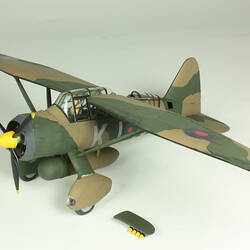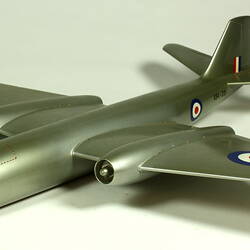Summary
Aircraft History:
The English Electric Company was a leading innovator in jet aircraft design. Their Canberra was the first British jet bomber to enter Royal Air Force sevice. Beginning in 1947, English Electric developed a supersonic interceptor fighter design with the design team led by W.E.W. 'Teddy' Petter, son of Sir Ernest Petter founder of the well-known Petter Limited engine manufacturing firm at Yeovil.
The three P.1A development aircraft proved the concept and a further three P.1B aircraft were built with two Rolls-Royce Avon jet engine, one above the other. The first F. Mk 1 Lightning entered RAF service with 74 Squadron in July 1960. English Electric were merged with the British Aircraft Corporation (BAC) in the same year. A series of modifications were made to improve armament and fuel tankage. During the Cold War period of the 1960s and 1970s it was the primary RAF interceptor fighter designed to respond to Russian bombers or patrol aircraft and were frequently based in West Germany. The Lightning was capable of Mach 2 or twice the speed of sound. A twin-seat training version was also built. Export orders were received from Saudi Arabia and Kuwait. In 1988 the Lightning was withdrawn from RAF service.
Model History:
This scale model was commissioned by the Museum and built by Mr R.D Ramsay.
More Information
-
Collecting Areas
-
Acquisition Information
Purchase
-
Manufacturer of Item Modelled
-
Model Name or Number
-
Brand Names
-
Classification
Air transport, Aircraft, Model turbo jet aircraft - military
-
Category
-
Discipline
-
Type of item
-
Keywords
Aeroplanes, Fighters, Jet Aircraft, Military Aircraft, Model Aeroplanes, Scale Models


